
The Journey Is the Destination
One of the most distinctive aspects of Tracker isn’t just the cases—it’s the roads taken to get there. With each new episode, Colter Shaw (played by Justin Hartley) moves across different states, towns, and terrains, tracking missing people in forgotten corners of America. But these aren’t just pretty backdrops. They’re integral to the story, shaping the emotional tone, tension, and themes of each case.
A Road-Trip Format With Purpose
Unlike most procedural dramas that are rooted in one city or a single police precinct, Tracker embraces a nomadic structure. Colter is constantly on the move, living out of his van and following leads wherever they take him. This structure allows the show to explore a wide swath of America—its diversity, its decay, and its beauty.
Each location tells a different story: a dusty Arizona highway where danger hides in plain sight, a coastal fishing village full of buried secrets, a tech-heavy city where anonymity is currency. The land itself becomes part of the mystery.
Landscapes That Mirror Emotion
The creative team behind Tracker has mastered the art of using location as mood. When Colter’s cases take him into the heart of the forest, it’s not just for suspense—it’s often a metaphor for being lost, both literally and emotionally. A frozen mountain pass underscores isolation. A sun-bleached desert amplifies emotional dryness or desperation. These environments don’t just set the scene—they set the stakes.
A Van That Goes Everywhere—But Is Never Truly Home

Colter’s custom van is the one “constant” in the series, but it’s also a symbol of how rootless he is. As he moves from place to place, solving others’ problems, he never settles long enough to confront his own. The ever-changing scenery reinforces the emotional truth: this is a man always on the run, even when he claims to be searching for something.
A Showcase of Forgotten America
Tracker doesn’t glamorize big cities or tourist destinations. It focuses on the often-overlooked pockets of rural and working-class America. The places that rarely get screen time—the ones filled with boarded-up diners, rundown motels, empty lots, and small-town suspicion. In doing so, the show offers a rare TV portrait of a side of the country that is often misunderstood or ignored.
Filming Realism: A Production Challenge and Achievement
From a production standpoint, the constant change in geography poses a real challenge. The crew must scout diverse locations, adapt to different weather conditions, and recreate convincing communities in short shooting windows. Yet they pull it off convincingly—each episode feels like a standalone film with a unique tone and visual language.
This attention to authenticity helps viewers stay immersed in Colter’s ever-shifting world. You’re not just watching a mystery unfold—you’re there with him, breathing the same dust, hearing the same creaks in old wooden floors, and sensing the same unease in the air.
Why the Settings Resonate
In many ways, Tracker is a story about what America looks like when no one is watching. It’s about the people and places left behind, the cracks in the system, and the quiet resilience of those who remain. By anchoring each episode in a distinct environment, the show captures the vast and sometimes contradictory soul of the country.
The Verdict: Tracker’s Real Star Might Be the Map
While Justin Hartley is undoubtedly the face of Tracker, the ever-shifting landscapes might be the show’s true co-star. Each episode’s setting deepens the emotional resonance, drives the plot forward, and challenges Colter in new ways. The show isn’t just a manhunt series—it’s a moving portrait of a country still trying to find itself.
